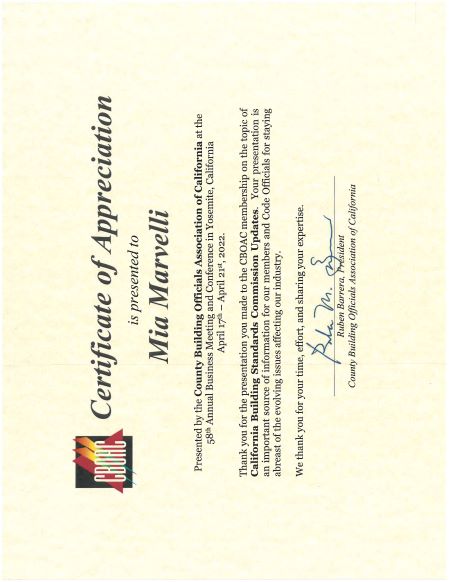CALCode Quarterly - Summer 2022
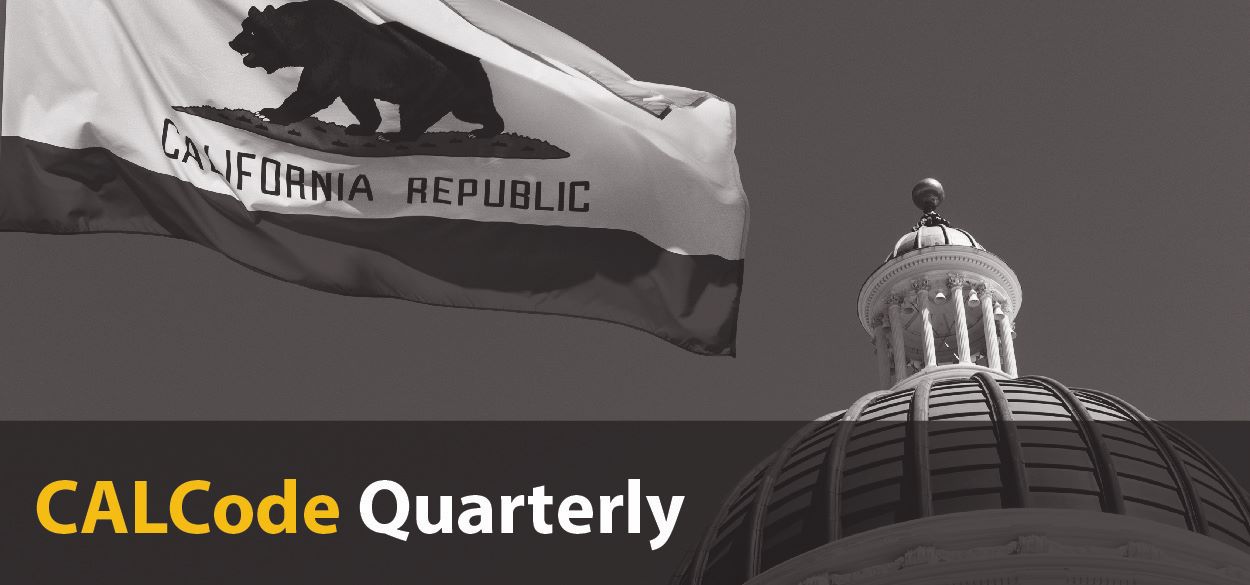

Executive Director Message
The 2022 edition of the California Building Standards Code, Title 24 of the California Code of Regulations (Title 24), was published on July 1 and can be viewed on CBSC’s website and is available for purchase from the publishers. The new edition of Title 24 is the result of more than 18 months of dedicated work by the staff of the California Building Standards Commission (CBSC) and many other state agencies that are tasked with adopting and amending model codes for use in California, as well as developing California-only codes such as the California Energy Code and the California Green Building Standards Code (CALGreen). During the 2021 Triennial Code Adoption Code Cycle, CBSC administered 45 rulemaking packages affecting every part of Title 24. We held five days of commission meetings in December 2021 and January 2022 to approve and adopt new regulations regarding permit expiration dates, wildland-urban interface exterior wildfire exposure safety, electric vehicle charging, health care facilities and much more.
Links to the publishers’ webstores can be found on the Codes tab of CBSC’s website. It is now possible to purchase the codes in electronic formats for ease of access and use. The International Code Council (ICC) is the publisher of Parts 1, 2, 2.5, 6, 8, 9, 10, 11 and 12; the International Association of Plumbing and Mechanical Officials (IAPMO) publishes Parts 4 and 5; and the National Fire Protection Association (NFPA) is the publisher of Part 3.
I am pleased to share that CBSC has developed several resources to help the regulated community become familiar with and use the new edition of Title 24. These include:
IB 01-22 – Announces the publication of the 2022 edition of Title 24 and provides other helpful information.
IB 02-22 – Information for local jurisdictions regarding making amendments to Title 24 for their community’s specific conditions.
IB 03-22 – Regarding Tentative Interim Amendments to the 2020 National Electrical Code.
2022 Title 24 California Code Changes – A new publication that summarizes California amendments made during the triennial code adoption cycle, available as a PDF document and a web page.
Guide to Title 24 – An in-depth look at Title 24 organization, use and enforcement that is recommended reading for all code users.
Guide for Local Amendments of Building Standards – Provides detailed information for local governments to adopt and amend regulations in Title 24, including which state agencies accept filings for certain amendments.
The 2022 edition of Title 24 moves California forward in reaching its goals for a safe and sustainable built environment in the state. CBSC would like to thank everyone who participated in the process last cycle and encourages others to participate in the upcoming cycle. The 2022 Intervening Code Adoption Cycle is already underway, with workshops being held regarding carbon-neutral development, expanded electric vehicle charging, and voluntary bird-friendly design. To find out when workshops are happening or when other public participation opportunities will occur, visit the 2022 Intervening Code Adoption Cycle webpage and subscribe to CBSC’s mailing list using the link on the left side of that page. Now is the time to make the broadest impact on the development of new codes. With the ability to attend any CBSC meeting virtually, participation in the code development process has never been easier. See the Cycle Status article below for more information.
I would like to recommend that code users also refer to the model code developers’ websites for the changes made to the model codes that form the basis of much of Title 24. State agencies are required by law to reference ICC’s International Building Code, International Residential Code, International Fire Code and International Existing Building Code; NFPA’s National Electrical Code; and IAPMO’s Uniform Plumbing and Mechanical Codes. In Title 24, there will be both newly adopted or amended model codes as well as California amendments and additions. Information about changes to the model codes can be found on the following websites:
IAPMO’s updates: iapmo.org/hidden/update-list/iapmo-publishes-2021-editions-of-uniform-plumbing-code-upc-uniform-mechanical-code-umc/
ICC’s significant changes: shop.iccsafe.org/supplemental/significant-changes.html
NFPA’s changes: catalog.nfpa.org/NFPA-70-National-Electrical-Code-NEC-Softbound
As always, call or email CBSC staff with questions about the Title 24 regulatory process. The phone number is (916) 263-0916, and the email is cbsc@dgs.ca.gov. If a question is outside of CBSC’s authority, we will assist in directing you to another state agency or resource. Best wishes for a prosperous summer, and we look forward to seeing you during the current 2022 intervening code development cycle.
Feature Articles
The 2022 Intervening Code Adoption Cycle will result in supplements to the 2022 edition of the California Building Standards Code, Title 24 of the California Code of Regulations (Title 24). This cycle will officially start in December of this year and will last approximately 18 months; however, the pre-cycle phase started earlier this year when state agencies began conducting workshops. The supplements will be published on January 1, 2024, with an effective date of July 1, 2024. See the timeline on the California Building Standards Commission’s (CBSC) cycle webpage for more information.
The purpose of this cycle is to adopt amendments to existing regulations that are needed to meet legislative mandates, modify or “clean up” existing code language, early adopt model code changes or address situations in the state that require new building standards.
The due date for state agencies to submit their proposals for the intervening cycle to CBSC is December 1, 2022. Over the past several months, and in months ahead, state agencies are holding pre-cycle workshops and other meetings to gather subject matter expert input for the development of the regulatory text. This is a time of information gathering and contributions by many stakeholders who can help develop code language that is usable, enforceable and meets the desired goals. Public participation by design professionals, builders and the enforcement community is highly encouraged during this time. Interested parties should sign up for CBSC’s mailing list using the links on our Contact page or rulemaking cycle webpage. You may also wish to sign up for mailing lists of other state agencies conducting their own code development workshops, as not all workshops are announced by CBSC. A list of state agencies and their areas of influence is shared on the Resources tab of our website, below the agency links.
Following the code development workshops, each state agency submits to CBSC a rulemaking file containing specified documents for each part of Title 24 they want to amend. Among other documents, this rulemaking file contains the Express Terms (regulatory language) and an Initial Statement of Reasons that provides supporting information for the proposed regulation, including the specific purpose and benefits, any studies or reports related to the proposal, evaluation of the impacts on small businesses, business expansion or job creation/elimination in California, and the estimated costs of compliance. There are many other requirements for proposed building standards, and you can learn more about this process in our Public Guide to the Building Standards Adoption Process or by watching CBSC’s video About the Rulemaking Process.
If you have any questions about the process or how to participate, please contact CBSC at (916) 263-0916 or cbsc@dgs.ca.gov.
Climate Action Via Code Change
by Michael F. Malinowski FAIAThe American Institute of Architects California (AIA CA) is the voice of the 11,000 architects and design professionals who design most of California's built environment. As a profession that prides itself on service to society and stewardship of our environment, we look broadly at how building design intersects with opportunities to address the many interconnected challenges we face in California, such as climate deterioration, our housing crisis, and equity and inclusion disparity.
Considered through this lens, even something as seemingly mundane as building code development takes on new importance. This shift was presaged in 2018 when the AIA Blue Ribbon Panel for Codes and Standards outlined a bold new vision of building codes and standards as valuable design tools for a resource-constrained and climate-challenged future.[1] This broader view maintains the traditional elements of life safety, fire protection, and structural and other system integrity. It also goes further by looking at the public health, safety and welfare impacts of a deteriorating climate, as well as the need for revitalization of our cities and economic opportunities for all our citizens. Two initiatives underway in the current intervening code adoption cycle for the California Building Standards Code, Title 24 of the California Code of Regulations (Title 24), provide specific examples of how these perspectives come together.
California Existing Building Code Working Group
Most of the buildings that will exist when we cross the environmental tipping point of climate deterioration are already here. How can we make these buildings more efficient while at the same time using the many underutilized or obsolete office, retail, and commercial structures that abound in our cities for new and innovative mixed-use housing development? To take this combination of unrealized potential opportunity and unmet environmental challenges and turn it to our advantage requires a robust code specific to existing buildings. This broad perspective was the driver behind an AIA CA petition to bring to California the full range of code compliance paths that already exist in the International Existing Building Code.
Getting seven additional chapters to fit into our California code framework is a complex and difficult task as it's not a simple "cut and paste." Each new sentence has to be carefully considered in relation to our complex existing legal and regulatory infrastructure. To accomplish this careful and public vetting process, hearings are currently underway under the auspices of the State Fire Marshal. AIA CA is committed to this major effort as we believe it will yield benefits that will touch communities and people throughout California for decades to come.
CALGreen Carbon Reduction Collaborative (CCRC)
AIA CA is proud to be among the founding entities of the CCRC, recently launched under the joint auspices of the Division of the State Architect, the Building Standards Commission, and the Department of Housing and Community Development. This working group is taking a broad look at how the California Green Building Standards Code, Part 11 of Title 24 (CALGreen), can better serve California in supporting a movement toward a sustainable, climate-supportive, resilient, and equitable future. Ongoing discussions include a number of potential additions to CALGreen, such as:
- Embodied carbon Because of the speed at which climate deterioration is occurring, it is essential to include the large near-term impacts of embodied carbon in our assessments. For example, when a building is torn down, much of the carbon used to construct it in the first place is immediately released back into the environment. Even a very high performing new building can take many decades to recover from this impact. Embodied carbon is a complex topic, so we are focusing on a limited number of materials where there has already been significant research and development, such as concrete which is a key component of every building.
- Whole Building Life Cycle Assessment Looking at greenhouse gas emissions from a whole building perspective is also going to be very important in limiting climate deterioration. Having the knowledge of what the actual impacts are is important to making the right decisions about design, materials, and infrastructure. AIA CA is suggesting starting with very large buildings of a limited range of occupancy types to get the industry familiar with using these analytical tools effectively.
- Zero Net Carbon Design AIA CA has been successful in a recent effort to require California’s licensed architects to acquire continuing education in the nuts and bolts of designing buildings that minimize greenhouse gas emissions. Establishing a framework for the terminology, metrics and practices in this evolving field is essential to our sustainable future as a state.
- Tier System With over 50 California jurisdictions adopting reach codes, the CALGreen tier system is an underutilized framework that could increase consistency and reduce the cost of adoption, implementation and follow through for everyone. AIA CA is interested in finding ways to use this CALGreen innovation more effectively in future code cycles for the broad benefits it can bring to communities, the building industry, and climate action.
More information on these efforts, including opportunities to participate, can be found on CBSC’s rulemaking webpages.
AIA CA supports the open, thoughtful, and methodical process used to develop California’s building codes. We know that it is important both to move quickly to address climate deterioration, while at the same time being careful to avoid unintended consequences and ensuring that all stakeholders’ perspectives are thoughtfully considered. We are confident that working together we can achieve the broad and essential benefits of new codes while at the same time ensuring continued advancement in economic vitality and increasingly diverse prosperity and health for our citizens.
[1] Disruption, Evolution and Change: AIA’s Vision for the Future of Design and Construction. content.aia.org/sites/default/files/2019-06/ADV19_Disruption_Evolution_Change.pdf
Michael F. Malinowski FAIA is a consultant to the American Institute of Architects California (AIA CA) on code and regulatory matters. AIA CA is an 11,000-member organization that is the voice of the architectural profession in California. It is dedicated to supporting architects in their endeavors to improve the quality of life for all Californians by a commitment to excellence, livability and sustainability in our built environment.
Executive Director Mia Marvelli and other California Building Standards Commission (CBSC) staff attended some events in person this year, which was a nice change from the past two years. Still, the use of virtual platforms continues to be a great way for people to connect across the state when they can’t all be in the same place at the same time. Here are some events we’ve participated in during the past few months…
April 17-21 – CBOAC in Yosemite
Mia spoke to the County Building Officials Association of California (CBOAC) annual business meeting about CBSC’s activities and the code adoption cycle status, including what to expect when the new edition of the California Building Standards Code, Title 24 of the California Code of Regulations (Title 24) is published. She was recognized with a certificate for her contribution to the meeting (see sidebar).

CBSC’s executive director Mia Marvelli (left) and Susan Dowty, ICC’s Government Relations Regional Manager.
May 9-12 – CALBO in Rancho Mirage
Mia gave a presentation at the California Building Officials (CALBO) annual meeting, sharing the publication status of Title 24 and what to expect from CBSC in support of the new edition of the code. She also shared information about the upcoming Intervening Code Adoption Cycle, which will result in supplements to the 2022 edition of Title 24.
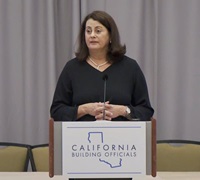
CBSC Executive Director Mia Marvelli.
AIA Board meeting (virtual) – May 13 and ICC San Diego (virtual) – May 17
Executive Director Mia Marvelli presented a detailed overview of CBSC’s code adoption process, including how and when the public can participate to have the most impact on code development. She also shared how most of California’s codes are based on national model codes developed by the International Code Council (ICC), the International Association of Plumbing and Mechanical Officials (IAPMO) and the National Fire Protection Association (NFPA), and how only some code—such as the California Green Building Standards Code (CALGreen)—are developed by California state agencies. During the presentation, Mia addressed specific questions from attendees relative to their areas of interest and expertise.
Green Technology’s Sustainable Facilities Forum – May 25
Each year, Green Technology, a non-profit organization with the goal of disseminating information and education about sustainable practices, holds a forum to bring together vendors, educators, government agencies, consumers and others. This year, after two years of virtual forums, the event was held in person again. Enrique presented information both live and to a virtual audience about the 2022 California Green Building Standards Code (CALGreen) updates, along with some history about CALGreen and how to use the tier compliance checklists.
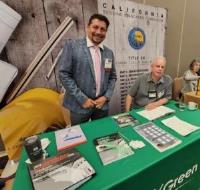
Associate Construction Analyst Enrique Rodriguez (left) and Architectural Associate Timothy O’Malley at CBSC’s forum table.
City of San Francisco Building Department (virtual) – June 1, 8 and 22
CBSC’s areas of expertise are non-residential CALGreen, CBSC’s rulemaking process administration, and how to use Title 24 and matrix adoption tables. For the City of San Francisco, CBSC presented each topic separately at the city’s weekly Wednesday morning meeting. If your building department staff is interested in any or all of these topics, please contact cbsctraining@dgs.ca.gov.
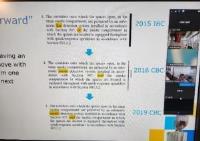
Online webinar reaches a large team of building officials in San Francisco
AHRI State Summit – State Agency Panel with SFM – June 8
CBSC Executive Director Mia Marvelli, Chief of Code Development and Analysis Greg Andersen from the State Fire Marshal, and Vice President of Codes and Standards Hugo Aguilar of IAPMO attended the Air-conditioning, Heating, and Refrigeration Institute (AHRI) state summit at the Kimpton Sawyer hotel in Sacramento. Each representative gave a short presentation about their organization’s role in the code development process, and answered questions regarding specific interests and concerns of those involved in the air-conditioning, heating and refrigeration industries.
Resources for the 2022 edition of Title 24
On the Resources tab:
2022 California Code Changes
(webpage and PDF)
Guide for Local Amendments
of Building Standards
Video about “Local Code Amendments”
Local Amendments Video PowerPoint
On the News tab:
Building Safety Month 2022
Governor Newsom Issued a Declaration for Building Safety Month in May 2022.
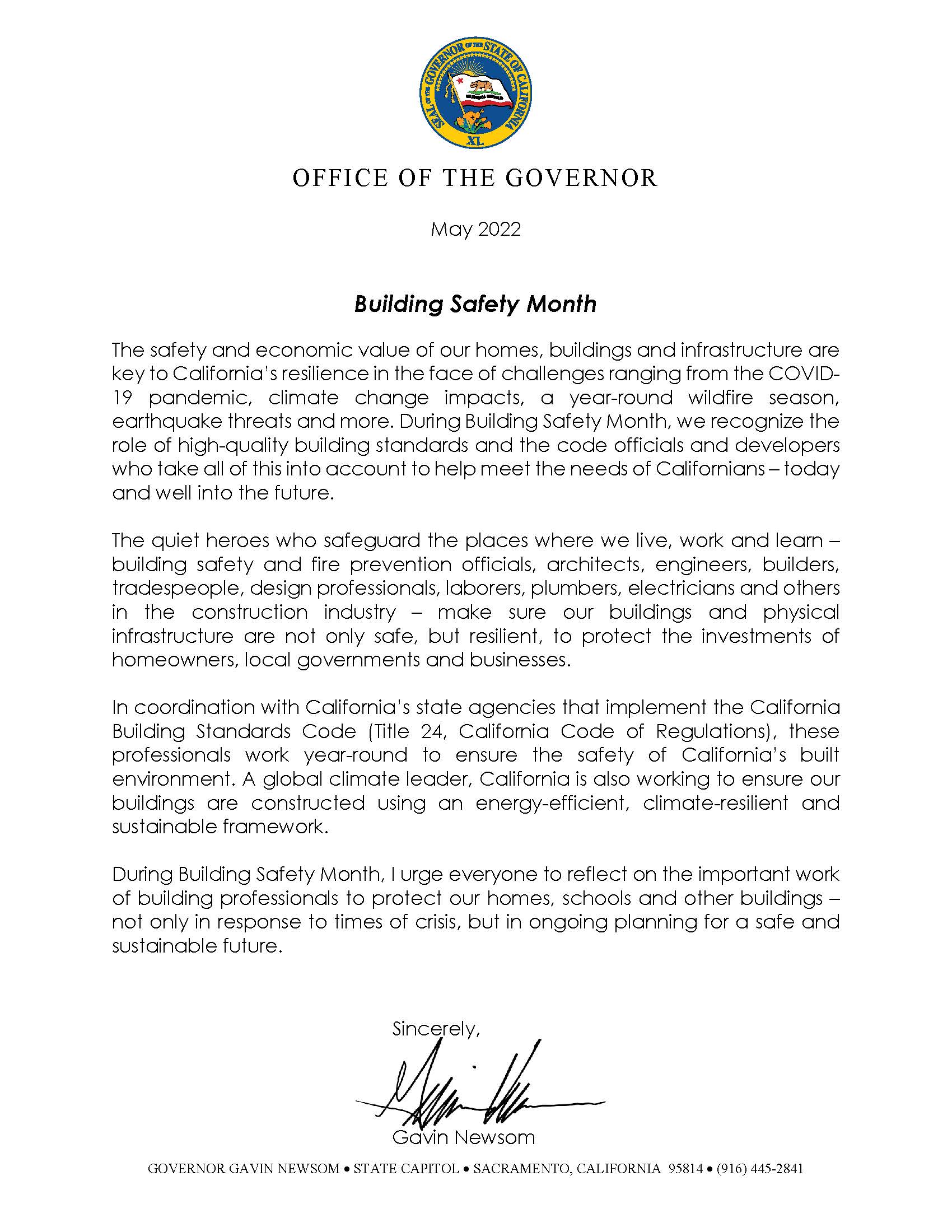
Executive Director Mia Marvelli Receives Certificate of Appreciation
CBOAC recognized CBSC's contributions.
